BIOL0510: Protists and Helminths (Eukaryotic Microbiology)
1/56
There's no tags or description
Looks like no tags are added yet.
Name | Mastery | Learn | Test | Matching | Spaced |
|---|
No study sessions yet.
57 Terms
List common infections caused by protists
malaria: spread via misquito bites
trichomonas: sexually transmitted protozoan infection (STI)
giardia: by drinking contaminated water; intestinal cramps and diarrhea
cryptospordium: #1 cause of recreational water disease outbreaks (ex. in lakes and ponds)
taxoplasma: forms cysts in muscles and brain; spread by cats

What are the four kingdoms of eukaryotes? Make sure to define any subcategories.
fungus
protists
protophyta: protists that are more plant-like (ex. have pigments seen in plants)
protozoa: protists that are more animal-like (ex. have motility structures)
animals
helminths
plants
What does the term “protist” mean?
describes any microbial eukaryote that is not a plant, animal or fungus (60,000-200,000 species)
Draw a more detailed phylogenetic tree corresponding to the branch of eukarya. Include plant, fungi, and animal branches
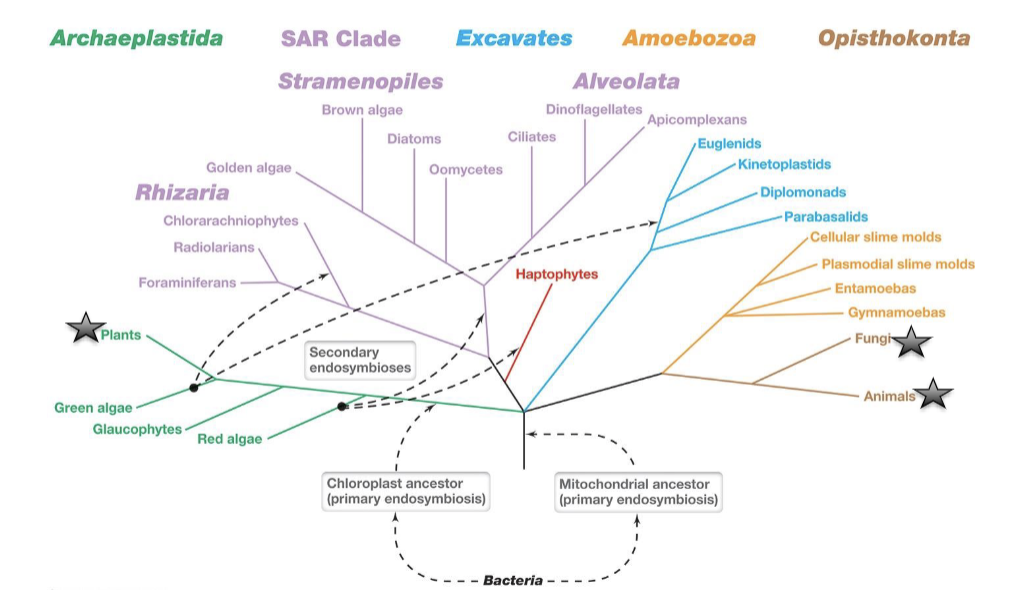
List the five protist clades
archaeplastida
SAR clade
excavates
amoebozoa
opisthokonta
Describe the archaeplastida clade
describes the entire plant kingdom and algae
all are photosynthetic
the lineage resulted from primary endosymbiosis (eukaryotic cell engulfed a cyanobacterium, where the two eventually evolved to depend on each other) of chloroplasts
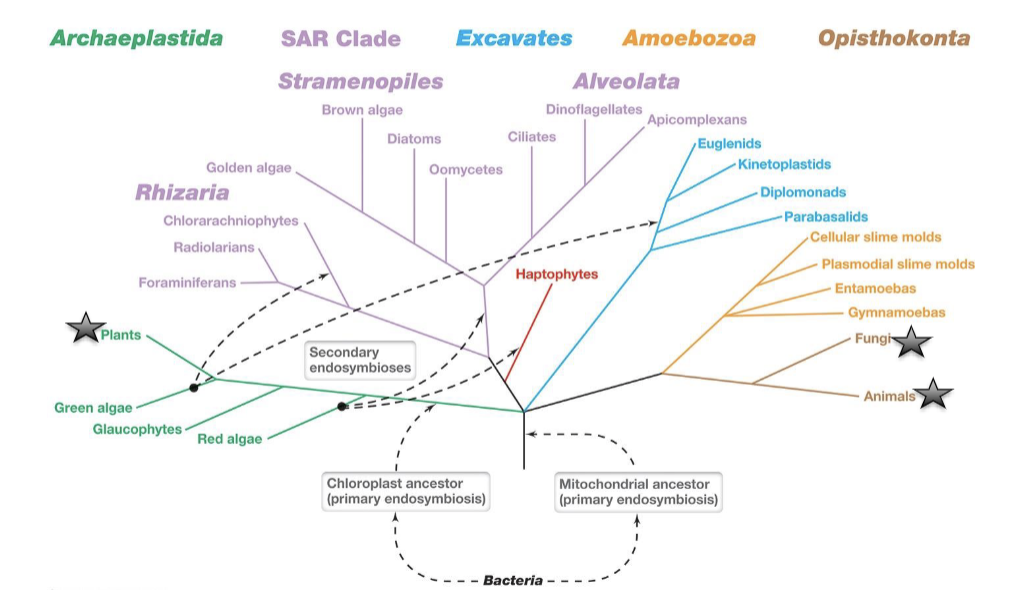
What evidence supports the endosymbiotic theory?
similar size as chloroplasts
MIN 15
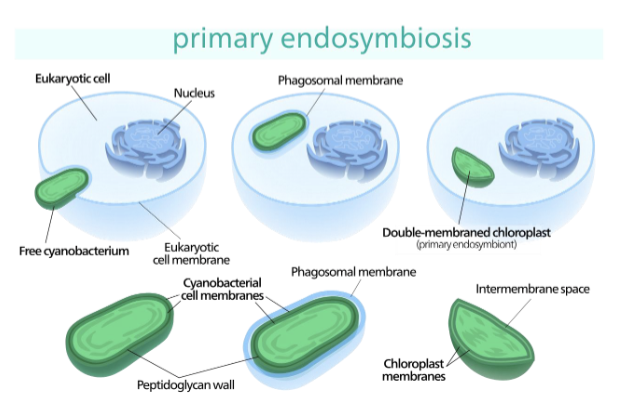
Describe an example of an organism from the archaeaplastida clade
characteristics:
examples:
Describe the characeristics of Stramenophiles (from the SARS clade)
characteristics:
short, hair-like extensions
chemoorganotrophic and phototrophic members
Describe diatoms: stramenophiles
in fresh water and marine habitats
cell walls made of silica
Describe oomycetes: stramenophiles
water molds - filamentous growth
cell walls are made of cellulose
Describe golden algae: stramenopiles
most are unicellular
motile via flagella and some are colonial
chloroplast pigments dominated by fucoxanthin
Describe brown algae: stramenophile
min 20
Potato famine example
min 20
Describe the characteristics of alveolata (SARS clade)
characteristics:
presence of alveoli (sacs underneath the cytoplasmic membrane)
ex.
cilliates
possess cilia at some stage in life
dinoflagellates
some are free-living
apicomplexans (causes malaria)
Describe Rhizaria (SARS clade)
characteristics:
have threadlike pseudopodia that they use to move and feed
ex. chlorarachniophyta, foraminifera, radiolarians
What is the difference between primary and secondary endosymbiosis? Use an example of each to explain
primary:
ex.
secondary:
ex. chlorarachniophyta: chloroplasts have 4 membranes (instead of 2) derived from engulfed eukaryotic algae
Describe the clade: Excavates
characteristics: an asymmetrical appearance with a feeding groove
Discuss 3 subgroups of excavates
diplomonads (cause waterborne illness)
have 2 equal-sized nuclei
ex. giardia intestinalis
parabasalids
lack mitochondria but have hydrogenosomes for anaerobic metabolism
most genes lack introns
ex. trichomonas (most common STI)
kinetoplastids (causes african sleeping sickness)
has a mass of DNA present in their single large mitochondrion
ex. LIST THE 3
break up this slide!!!!!
List the characteristics of amoebozoa
terrestrial and aquatic
use pseudopodia for movement and feeding
ex.
slime molds
gymnamoebas
entamoebas
List and describe the subgroups of amoebozoa
gymnamoebas
entamoebas
slime molds
Describe opisthokonta clade
includes animals, fungi, and. the protists Choanoflagellida and Nucleariidae
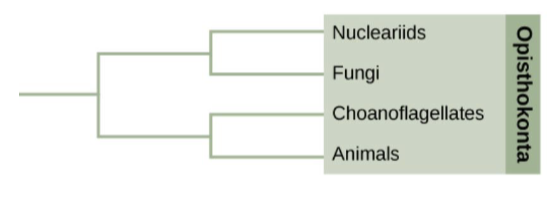
NEED TO KNOW OF THE STUFF IN SLIDES 1-22
name and list characteristics of 3 nonpathogenic protists
Describe parasitism
a type of symbiosis: organisms that obtain food and shelter by living on or within another organism
physiologically and metabolically dependent on the host
kinds of symbiosis: commensalism, mutualism, parasitism
What is a parasite in medical terms?
a eukaryotic pathogenic organism belonging to protozoa and helminths
List and define the different types of parasitic hosts?
host:
definitive host: the organism that the parasite lives in during its adult and sexual stage
intermediate host
vector
reservoir host
paratenic host
Explain the two ways parasites are transmitted?
direct: 1 host
ex. cryptosporidiosis in contaminated water is ingested by a person who then becomes the definitive host
indirect: intermediate host
the duck is the definitive host because it produces an egg which transmits the pathogen to the snail and, eventually, the human
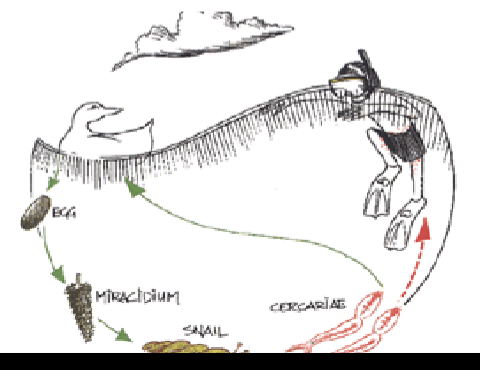
Define the types of parasites
obligate: only live in host
facultative: live in host or free form
endoparasites: live inside host body
ectoparasites: live on host body surface
epiparasites: live in or on another parasite
What is the difference between horizontal and vertical parasite transmission?
horizontal: from infected host to neighbor
vertical: mother to offspring (during fetal development - 2 weeks post-birth)
rare with parasites
both apply to bacteria as well
What is spillover and spillback transmission?
spillover:
spillback:

Know 3 examples of maternal-fetal infections
List the 3 types of protist (protozoan) infections
trypanosomes
leishmania
trichomonas
toxoplasma
Describe Leishmaniasis (cause, cases, symptoms (3), hosts, and target)
cause: several Leishmania genus species
cases: 12 million, 1 million/year
symtoms:
cutaneous lesions that eventually create ulcers
mucocutaneous ulcers develop on the oral or nasal mucosa
visceral: found throughout the body
hosts: multiple (ex. humans, dogs, monkeys)
target: macrophages
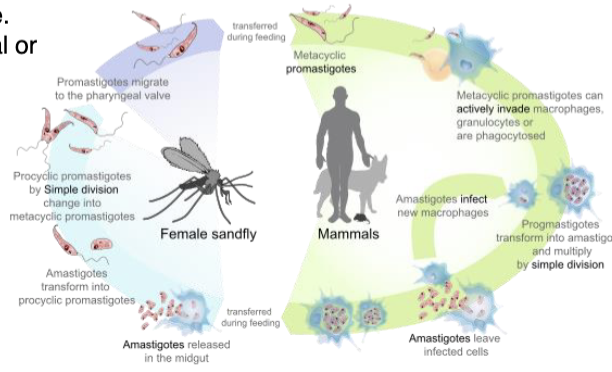
Describe Trichomoniasis
what: trichomonas vaginalis (most common STI)
cases: 2 million/year
host: more common in women
symptoms: 70% of patients are asymptomatic
Describe Toxoplasmosis
cause: Toxoplasma gondii
cases: worldwide distribution (1/3 of the population has it)
symptoms: mostly asymptomatic
symptomatic people develop cysts in muscles and sometimes other tissues (ex. brain)
spreads: via domestic cats
rare complications:
pregnancy: premature birth, stillbirth, miscarriage, blindness, fetal brain damage
immunosuppressed people at risk of encephalitis, myocarditis, and pneumonitis
Describe the lifecycle of toxoplasma
cysts ingested by cat (definitive host)
unsporulated toxoplasma oocytes are released in feces
oocytes sporulate and spread to food, water, or soil, eventually being ingested by intermediate hosts (mice)
cysts form in intermediate hosts’ tissues
ingesting cysts in infected meat (raw or undercooked) passes toxoplasma to humans
tachyzoites can then be transmitted through placentas to fetuses
List examples of helminths and their death rates
Describe helminths
in the animal kingdom
invertebrates
macroscopic and multicellular
considered worms
either free-living or parasitic in nature
1/3 of world population is infected with a helminth currently
List the elements of helminth anatomy
they are cephalopods (have a head)
bodies covered in tough cuticle
How do worms acquire nutrients in host?
through absorption or ingestion of host body fluids
HIGHLY DEVELOPED… FINISH
Why are we worried more about oviparous infections than viviparous worm infections?
oviparous
List elements of helminths that aid in their defense mechanisms
tough cuticle protects from enzymes
large size
elaborate attachment to host
might have multiple hosts and shift to the more favorable environment at a given time
hide out in immunologically protected areas (brain, spinal cord)
can sometimes suppress host immune system
shed surface antigen once host antibodies attach to surface
Which types of worms cause human infections?
platyhelminthes (flatworms) and nematoda roundworms
Describe flatworms (platyhelminthes)
physical: soft body, ribbon-shaped, flat, mucoid, eye spot and brain, incomplete digestive system (no anus)
undulating form of locomotion
What are the two subcategories of flatworms we discussed?
trematodes (flukes)
cestodes (tapeworms)
Describe an example of a trematode: Schistosomiasis (snail fever)
definitive host: human
intermediate host: snail
area: subsaharan Africa
infection: egg in fecal material gets to drinking water; uses snail as intermediate host to mature; passes to fish; human eating the fish acquires infection
Describe cestodes
min 4:10
List the characteristics of nematodes (roundworms) and provide examples
unsegmented, cylindrical fusiform body that is bilaterally symmetrical
ex.
whipworms
FINISH
Describe the nematode case study: lymphatic filariasis
min 73
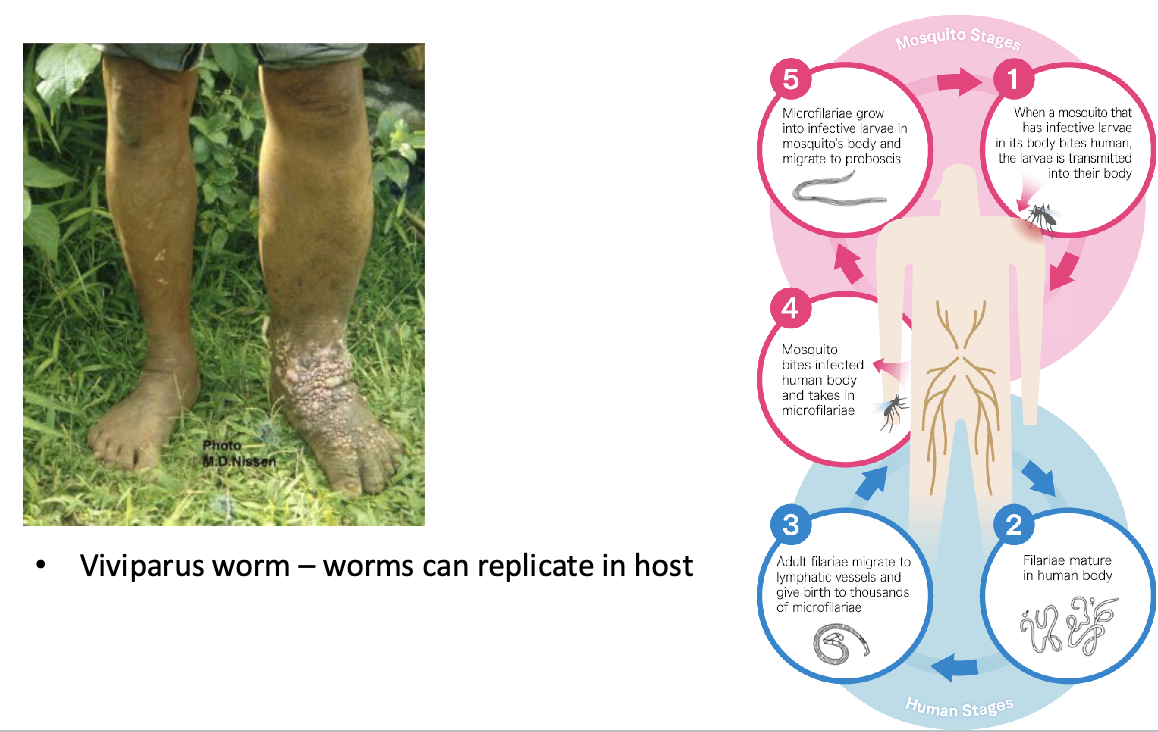
Describe the nematode case study: Guinea worm
nematode: Dracunculus medinensis
prevalence: 14 human cases in 2024
contraction: ingesting contaminated water
symptoms: itch that only feels better when skin is subjected to water
problem: when affected body parts are submerged in water, the female worm releases larvae, which are ingested by copepods (fish that are eaten again by humans, thus spreading the infection)
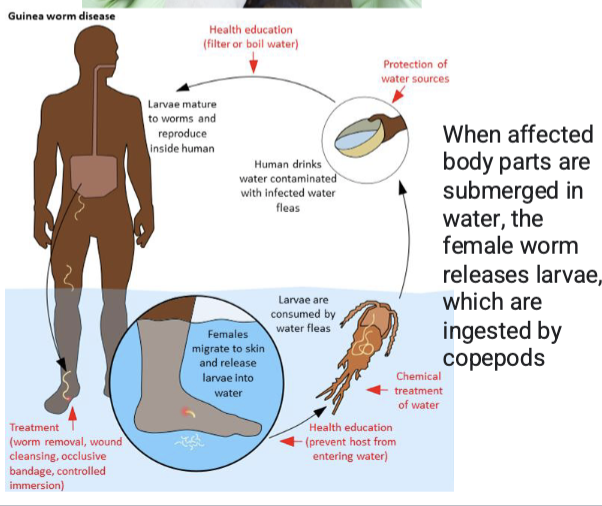
Which populations are at risk for helminth infections?
FINISH
How are helminth infections diagnosed?
asking about travel history and food intake
elevated eosinophil numbers (a type of WBC)
morphological
FINISH
What treatment exists for helminth infections?
prevention: increasing sanitation
early chemotherapy
was toxic
heavy metals (arsenic)
quinine (toxic metabolites accumulate in parasite cells)
f
p
What is premunition? Why might it be good to have it for a helminth infection?
resistance to a disease due to the persistence of viable organisms at low concentrations within the body of the host
a small amount of helminths in the body can provide immunity
How do eosinophils and IgE work together to expel worm infections?
Describe the hygiene hypothesis
an ultra-hygenic environment fails to educate our immune system and increases the risk of developing allergies, asthma, and autoimmunity